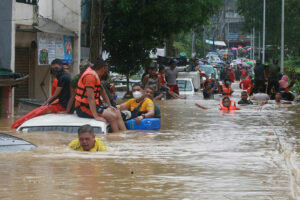Climate-vulnerable nations could get insured for $10M a year each

BRUSSELS/LONDON — Wealthy nations could provide 100 of the world’s most vulnerable countries a combined $25 billion in annual protection against climate disasters for as little as $10 million per nation, research published on Tuesday showed.
The findings come a week ahead of the U.N.’s COP28 climate summit in Dubai, where countries are set to launch a world-first fund to help countries cope with the costs of climate damage.
With rich nations under pressure to fill the pot, researchers from the University of Cambridge’s Institute for Sustainability Leadership said they had reached a “breakthrough” in understanding how to use this money to protect countries from the spiraling cost of storms, drought and rising sea levels.
First, their findings confirm that the world’s most climate-vulnerable countries remain insurable until 2050 among reinsurers and others in the capital markets, based on modelling of the risks climate change is inflicting on them.
“This is massive, because there is the preconception that these countries are untouchable,” Dr Ana Gonzalez Pelaez, lead author on the study, which was shared exclusively with Reuters ahead of publication. “Actually, we do have the figures that show that they can be insured,” she said.
Second, the researchers demonstrated how risk sharing systems — essentially, insurance — could use contributions from donor countries to fund climate damage protection “premiums,” that would massively scale up the protection available to vulnerable nations.
Donor funds of $10 million per recipient country, when used as premium support, could yield $200 million to $300 million per country in pre-arranged annual protection, for a combined $25 billion if rolled out across 100 countries, the researchers said.
The scheme would use this relatively modest donor funding to provide insurance against far more costly, but unpredictable, climate risks like hurricanes and floods, which may only occur once per decade or every few decades.
“The idea is to use that new source of funding to protect these countries at a structural level,” said Rowan Douglas, chief executive officer of Climate Risk and Resilience at UK-based insurance broker Howden, which co-authored the research.
“At the moment, there’s no product out there that protects national economies in this sense,” Mr. Douglas added.
The need to act is acute. Small Island Developing States face potential losses of between 50% and 300% of their gross domestic product from extreme climate events, the study said.
Sara Jane Ahmed, finance adviser to the V20 group of climate-vulnerable countries’ finance ministers, said more also needed to be done to ensure market providers offer premiums offered to vulnerable countries at affordable prices.
“Currently, no climate vulnerable country part of a regional disaster risk insurance pool can buy coverage at optimal insurance levels; and that is simply because they can’t afford to,” she said. — Reuters




